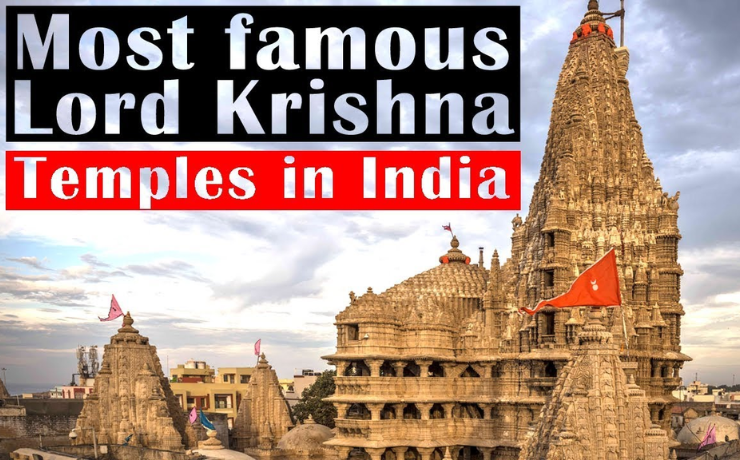Lord Krishna is the supreme personality, guide, philosopher, brilliant strategist, and guide of all living and nonliving things. Lord Krishna stated in the holy scripture Bhagavad Geeta that he is the key to everything. Janmashtami, the birth ceremony of Lord Krishna, is just around the corner, and thousands of Lord Krishna temples around the world are preparing for the festival. If you want to learn more about how the festival is celebrated in India, here are the top Lord Krishna temples in India where you can see the lord’s glory.
- Prem Mandir, Vrindavan, Uttar Pradesh
Located in the divine town of Vrindavan, Prem Mandir means, the temple of divine love. The temple is dedicated to the divine couples Radha Krishna and Sita Ram. The temple is constructed with ivory white Italian marble, and the temple has mirror paintings on each wall that depicts the major events of Lord Krishna’s life. The temple is surrounded by beautiful gardens and fountains, there are also life-size depictions of Shri Krishna leelas.

- Banke Bihari Temple, Vrindavan.
Banke Bihari Temple is an ancient Lord Krishna Temple established by Swami Haridas. In this temple, Lord Krishna is worshipped as Banke Bihari which is a combined form of Radha and Krishna. The temple is an architectural beauty and was constructed in Rajasthani style in 1864. It is believed that one who stares long enough into the eyes of Bankey Bihari Charming idol, the person would lose their self-consciousness.

- Dwarkadish Temple, Dwarka, Gujarat
Dwarkadish Temple is one of the most famous Lord Krishna Temples in India. The magnificent temple is built in Chalukya Style architecture made of limestone and granite. The temple is also a part of the Charm Dham Yatra. It is also known as Jagat Mandir and as per the ASI, the temple is around 2,500 years old. The main temple is supported by 72 pillars and it is believed that Lord Krishna’s grandson built the original temple. The existing temple is dated back to the 16th Century.

- Jagannath Temple, Puri, Odisha
Jagannath Temple is a popular holy shrine that has attracted Krishna devotees across the world. The temple is known for the famous Rath Yatra and the many mysteries surrounding the temple. It is said that no birds fly over the temple, and the flag on top of the temple sways in the opposite direction of the wind. The holy shrine is the home of Lord Jagannath, Lord Balabhadra, and Goddess Subhadra.

- ISKCON Temple, Bengaluru (Bangalore)
ISKCON Temple, also known as Shri Radha Krishna Temple, was built in 1997 and is a magnificent Lord Krishna Temple in India. The temple is built on the top of Vaikuntha Hill. ISKCON Bengaluru (Bangalore) has six shrines dedicated to Radha Krishna, Krishna Balrama, Nitai Gauranga, Srinivasa Govinda, Prahlada Narasimha, and Srila Prabhupada. The temple provides free food for all those who are in need. The foundation was set up in the year 2000 and runs the world’s largest NGO Mid-Day Meal program.

- Guruvayoor Temple, Guruvayur, Kerala
Guruvayoor Temple is also called the Dwaraka of the South. The temple was built in 1638 AD. The four-armed statue of Lord Krishna adorns the holy tulsi garland and pearl necklace. There is a big tank in the temple and it is believed that this is the place where Lord Shiva’s family worshipped Lord Vishnu. During the festival times, the temple attracts a huge crowd and there is a special elephant feeding program that takes place at 10 AM in the temple daily.

- Rajagopalaswamy Temple, Mannargudi, Tamil Nadu
Rajagoapalswamy Temple is one of the oldest and most beautiful temples of Lord Krishna in India. Here Lord Krishna is worshipped as Rajagopalaswamy. The original temple was constructed in the 10th century during the Chola period and it was renovated during the 16th century. In this temple, Lord Krishna along with Rukmini and Satyabhama are worshipped as the main deities. The temple is also called Srividhya Rajagopalaswamy temple. Along with the Guruvayoor temple in Kerala, Rajagopalaswamy temple is also called Dakshina Dwaraka.

- Shri Krishna Temple, Mathura
The Shri Krishna Janmabhoomi temple in Mathura is a sacred Lord Krishna temple in India. The temple was constructed by Lord Krishna’s great-grandson named Vajranabha. The important place in the temple complex is the Garbha Griha temple, it is believed to be where Lord Krishna was born. The temple is one of the popular Krishna Temples to be visited during Janmashtami.

- Balakrishna Temple, Hampi
Balakrishna Temple is one of the most beautiful and famous Krishna Temples in India. Sri Krishnadevaraya built the temple to celebrate his victory. The temple is also a part of the UNESCO World Heritage Site. In this temple, you will see Lord Krishna in an infant form. The temple is known for its elegant carvings and architectural designs and is adorned with small shrines and surrounded by Banana plantations.

- Bhalka Tirth Temple, Somnath, Gujarat
Bhalka Tirth Temple is a sacred temple located close to the Somnath temple in Gujarat. It is believed that Lord Krishna was injured by a hunter’s arrow at this place which led to the end of the Krishna avatar. This Leela of Lord Krishna is immortalized in this temple. Inside the temple, we can see Lord Krishna sitting in a resting position blessing the hunter Jara.

Conclusion: These are some of the popular Lord Krishna Temples in India that you must visit to witness the birth ceremony of Lord Krishna. Though Lord Krishna is worshipped in different forms, he is always the supreme personality and the protector of this universe.






























